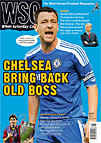 Visiting teams complain about the pitch, but the Luzhniki Stadium deals with the Russian weather, writes Sasha Goryunov
Visiting teams complain about the pitch, but the Luzhniki Stadium deals with the Russian weather, writes Sasha Goryunov
In May 2008, Chelsea and Manchester United contested the Champions League final at the Luzhniki Stadium in Moscow. There was something unusual about the playing surface: it was grass. For one match only, turf was brought in from Slovakia. In fact, this was the second set of imported grass. The original failed to take root and had to be replaced just two weeks before the game. John Terry might wish they hadn’t bothered.
The Soviet Union’s main sporting venue was opened as the Lenin Central Stadium in July 1956. It was modernised for the Moscow Olympics in 1980, but was obsolete by the mid-1990s. After Spartak beat Blackburn Rovers 3-0 in the Champions League in 1995, the stadium was closed for reconstruction for almost two years. To comply with the UEFA regulations coming into force in 1998, the arena was refurbished and a roof was installed. It was deemed good enough to host the 1999 UEFA Cup final between Parma and Marseille and received a five-star ranking from UEFA.
There was a serious problem with the playing surface. The grass was dying due to lack of air circulation and sunlight. The new Wembley stadium had similar problems, which were alleviated with the construction of four access tunnels in the corners of the stadium. The structural tweaks attempted at the Luzhniki did not work and the problem was exacerbated by the poor drainage of the soil. The pitch was relaid several times but, by 2002, Vladimir Aleshin, who effectively owned the stadium, gave up.
In May 2002 he ordered an artificial surface with undersoil heating from the Canadian company FieldTurf. The first match after the changeover took place in July 2002, as Torpedo hosted Rostselmash. As the pitch received a two-star rating from FIFA it was allowed to host matches in UEFA competitions. In September 2006 the first Champions League match on synthetic turf was played between Spartak and Sporting Lisbon. Only a year later the British were up in arms. First Celtic, then England complained about the “plastic” pitch that was already five years old. Tarkett, the company that took over FieldTurf in 2005, argued that replacing the surface before the Champions League final would be pointless. They upgraded instead to a better artificial turf in 2008.
Spartak continue to be the main tenants of the stadium. To facilitate the almost weekly switches between natural and artificial pitches, the players prepare before games on the appropriate surface at the club’s Tarasovka training base near Moscow. The medical staff have their work cut out, given the difference in the body’s reaction to the two types of surface. Research indicates that even the latest artificial surfaces cause more muscle strains, hamstring problems and ankle injuries. However, unlike most European leagues, no official injury data is submitted by the Russian Premier League to UEFA.
Spartak’s training facilities are often better than the matchday pitches. The grass pitch is in such good condition that Spartak recently received a visit from Kazan, where the ground staff are struggling with the natural surface. Rubin’s Europa League match against Olympiakos had to be switched to the Luzhniki. After hosting Spartak in early March, the next home game had to be played at the back-up stadium.
The difference with the other Premier League artificial surface, at the Zvezda stadium in Perm, is even more significant. On moving from Amkar Perm to Spartak in 2010, the Montenegro international Nikola Drincic commented that the Luzhniki pitch was “softer and more comfortable” than the one he left behind. Playing in Perm has also been likened to playing on concrete.
Spartak dream of leaving Luzhniki and its pitch behind for their own stadium, which is being built in the Tushino area of Moscow with the projected completion in 2013-14. But as Lokomotiv Moscow, who are currently struggling with deteriorating grass cover at their home ground, found out, owning a stadium might not be the answer to all the questions asked by the Russian weather. The cold snap in February meant that they also decamped to the Luzhniki Stadium for their Europa League tie. The quagmire in Khimki during the recent match between Dynamo and Spartak should also serve as a warning that if you go “natural” in Russia, you should really have artificial turf as back-up.
From WSC 303 May 2012